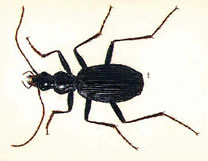Insects and spiders as forest indicators
Arthropods (insects and spiders) represent about 70% of all forest species, and play an important role in forest ecosystems.

Arthropods are increasingly being used as ecological indicators because of their responsiveness to environmental conditions, as well as their diversity and abundance. For example, some species, such as carabids (ground beetles) are useful in assessing recovery after disturbance, and the impact of forestry practices.
Canadian Forest Service (CFS) researchers and collaborators have determined that while carabid assemblages respond to disturbance, the response of individual species and changes in species composition are influenced by regional geography and fine-scale differences among forest ecosystems. As a result, researchers have concluded that monitoring carabids is better suited to finer scale evaluations of the effects of forest management. In addition, monitoring individual species of arthropods over large landscapes is economically prohibitive.
CFS researchers are looking at whether ecological or habitat surrogates, such as the Canadian Forest Ecosystem Classification System (CFEC), can be monitored instead of arthropods directly—at a more reasonable cost.
CFEC is useful for classifying and monitoring plant communities within Canadian forests. The CFEC was constructed using vegetation data and soil characteristics (moisture and nutrient richness), properties that are also known to have strong influence on the distribution and abundance of ground-dwelling (epigaeic) arthropods, including carabids. Research suggests that this classification for forest plant communities is also a surrogate for forest epigaeic arthropod communities. In other words, the widely-used and easily-understood CFEC not only allows the assessment of plant communities in Canadian forests, but also makes it possible to indirectly monitor epigaeic arthropod biodiversity.
CFEC, which has the potential to be applied over large landscapes to evaluate forest change and trends in forest organisms, may also be used to assess impacts of climate change, bioenergy development and oil sands resource extraction.
Canadian Forest Service key contact
David Langor, Entomologist, Biodiversity and Pest Management
Page details
- Date modified: